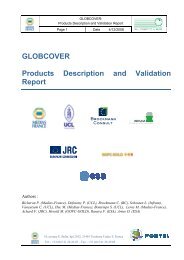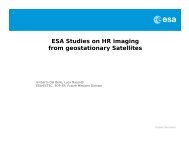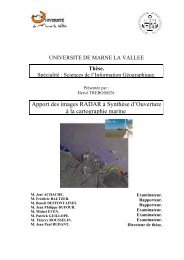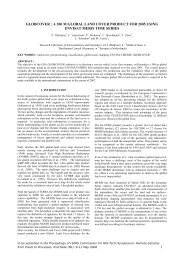Medspiration â System Requirements Document - Data User Element
Medspiration â System Requirements Document - Data User Element
Medspiration â System Requirements Document - Data User Element
You also want an ePaper? Increase the reach of your titles
YUMPU automatically turns print PDFs into web optimized ePapers that Google loves.
<strong>Medspiration</strong> MED-SOC-RS-001_1<br />
<strong>System</strong> <strong>Requirements</strong> <strong>Document</strong> Issue F<br />
Page Table, fig. Reference ID Text from reference documents<br />
SR entry<br />
62 WP-ID2.2.2.5 TMI SST retrieval below 285 K<br />
62 WP2-203 TMI retrieves SST primarily from the 10.7 GHz channel, which has decreased sensitivity (and therefore increased error) at<br />
CFD.0160<br />
SSTs below 285K. Although the bias at lower temperatures is negligible, the standard deviation increases (as reflected in<br />
the SSES). TMI data having retrievals below 285K must be flagged according to the following GDS rule:<br />
62 Rule<br />
WP2-204<br />
· Rule 2.2.2.5: If a TRMM TMI SST measurement value is less than 285K, bit 2 of the L2P confidence data variable<br />
CFD.0160<br />
2.2.2.5<br />
MW_SST_flags should be set.<br />
62 WP-ID2.2.2.6 High Wind retrieval, above 12 ms -1<br />
62 WP2-205 Uncertainties in the emissivity model at high winds and increased errors in the directional model, result in larger errors<br />
CFD.0170<br />
above 12 ms -1 . These errors should not vary temporally or spatially since they are due to uncertainty in the estimate of<br />
emissivity. Although this increased error will be reflected in the SSES, some data users may chose to simply exclude these<br />
retrievals as suspect.<br />
62 The GDS specifies the following rule:<br />
62 Rule<br />
WP2-206<br />
· Rule 2.2.2.6a: If a microwave wind speed measurement contemporaneous with a microwave SST measurement is<br />
CFD.0170<br />
2.2.2.6a<br />
greater than 12 ms -1 , bit 3 of the L2P confidence data variable MW_SST_flags should be set.<br />
62 Rule<br />
WP2-207<br />
· Rule 2.2.2.6b: If a contemporaneous microwave wind speed measurement is unavailable, the nearest NWP analysis<br />
CFD.0180<br />
2.2.2.6b<br />
in space and time toi the SST measurement should be used to evaluate Rule 2.2.2.6a.<br />
62 WP-ID2.2.2.7 Derive a Microwave Proximity Confidence Value (MPCF)<br />
62 WP2-208 MPCV data are analogous to Infrared Proximity Confidence Values (IPCV) and provide a method to better understand the<br />
CFD0210<br />
character of microwave SST and their relationship to the SST1m. Microwave SST measurements are known to be of a<br />
reduced quality when they are in close proximity to clearly flagged rainfall, due to side lobe contamination in the proximity<br />
of land and sea ice. Also, at wind speeds < 2 ms -1 , a cool skin effect may also exist whereas at high wind speeds the<br />
emissivity model used to derive SST is poorly defined. These factors may be used to derive a Proximity_Confidence<br />
© 2004 SOC Page 154 of 193








